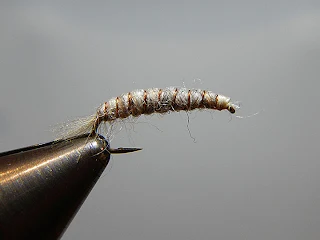Hook: Mustad S80-3906 (https://amzn.to/3qlSsIY)
Size: 10 - 16
Thread: UTC Ultra Wire, Black in size Brassie (https://amzn.to/37gXKhj)
Body: Green Yarn (https://amzn.to/2LOSw4Q)
Head: UTC Ultra Wire, Black (https://amzn.to/37gXKhj)
The "Killer Rock Worm" a variation of Frank Sawyer's "Killer Bug." Using black wire and green yarn. Change yarn and wire color to mimic the caddis larva in your waters.
The Killer Bug is famous in the U.K. and Europe and recently has this pattern gained a following in the U.S. This fly is renowned for its catching fish and the mythological properties of Chadwick's 477 wool used in its construction.
Frank Sawyer was a river keeper on the River Avon at Lake in Wiltshire in the U.K., along with being a writer and inventor of such flies as the Pheasant Tail Nymph.
The killer bug was developed by Mr. Sawyer to manage the grayling numbers on the River Avon. Then Grayling considered a coarse fish and undesirable as a food or game fish.
If you're looking for an available substitute, Semperfli Chadwicks 477 Substitute (https://amzn.to/3de9ll5) is an excellent choice.
Fly Tying Gear:
Regal Stainless Steel
Revolution and Base (https://amzn.to/3gxmQvL)
Regal Vise Tool Bar
Attachment (https://amzn.to/2IxpKEe)
Cohen's Sculpting
Scissors
Tiemco Ceramic Bobbin (https://amzn.to/3u7Gkxv)
Matarelli Whip Finisher
(https://amzn.to/370HxNu)
Solarez Bone Dry (https://amzn.to/3m3o4jn)
Camera Gear:
Camera: Panasonic GH4
(https://amzn.to/2ItiCsu)
Lens: Panasonic 30mm
Macro (https://amzn.to/3n0ZZe)
Ring Light: Neewer 48
Macro LED (https://amzn.to/2VUSfii)
Fill Light (3): Aputure
H198 (https://amzn.to/39V2D1S)
Battery: Wasabi Power
Battery and charger. (https://amzn.to/2VRyo3s)
Backdrop: Dark Grey &
Light Grey (https://amzn.to/33UzUX3)
Using affiliate links helps support the channel at no cost to you, thanks.
© 2021 Louis DiGena All Rights Reserved.
#loudigena #flytying #flyfishing
















































